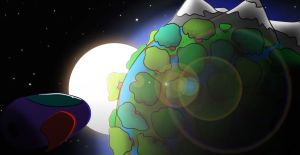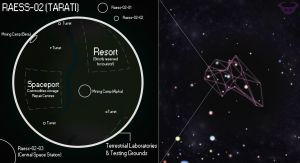Tarati: Difference between revisions
(Add image) |
No edit summary |
||
| Line 4: | Line 4: | ||
[[File:Tarati.jpg|alt=Satellite view of Tarati with Raess in the background|thumb|Satellite view of Tarati with Raess in the background]] | [[File:Tarati.jpg|alt=Satellite view of Tarati with Raess in the background|thumb|Satellite view of Tarati with Raess in the background]] | ||
Tarati is the second planet in the solar system Raess. It is a goldilocks zone planet and home to a wide range of flora and fauna. Tarati is divided into two main biomes: The [[Alpine Zone]], located on the north and south poles, and the [[Jungle Zone]], located on the equator. | Tarati is the second planet in the solar system Raess. It is a goldilocks zone planet and home to a wide range of flora and fauna. Tarati is divided into two main biomes: The [[Alpine Zone]], located on the north and south poles, and the [[Jungle Zone]], located on the equator. | ||
{| class="wikitable" | |||
! colspan="2" |Tarati | |||
|- | |||
!Size | |||
|??? | |||
|- | |||
!Moons | |||
|2 | |||
|- | |||
!Year Length | |||
|??? | |||
|- | |||
!Day Length | |||
|16 hours | |||
|- | |||
!Climate | |||
|Temperate | |||
|- | |||
!Avg. temp | |||
|5C, 41F | |||
|} | |||
Tarati is a small planet home to a variety of life. The poles have absurdly large jutting mountains. the equator is covered with lush green swamps and forests. | |||
=Climate and Geography= | |||
Tarati has a high humidity rh 50-60 and low oxygen density. Tarati has multiple small volcanoes which erupt around the same time each year. Tarati's mountains are so high that they extend into the stratosphere. For this reason there is no snowfall on the tips of the mountains. further down the slopes there is a thick coating of snow and ice. This layer of alpine snow melts regularly to form a network of rivers flowing towards Tarati's equator. Tarati has no seas, but the swamps at the equator where the rivers meet is slightly saline. | |||
=Measurements of Time= The length of a day on Tarati is 16 hours. A year on Tarati is approximately 0u82e49019 earth years. The [[Toki]] race on tarati refers to a year as a "cycle". Each cycle takes 8 months. The tokian race has named their months after the eight elemental deities of the main religion. The names of these months help tokis to remember the seasonal changes in a cycle. * spring - the month of air shi * late spring early summer - the month of thunderstorms zut * summer - the month of fire ray * late summer early autumn - the month of volcano eruptions plus * autumn - the month of earth kun * late autumn early winter - the month of hunting tung * winter - the month of water wysh * late winter early spring - the month of ice and cold cryk ecology ecology ecology category planets | |||
== History == | == History == | ||
Revision as of 04:00, 26 January 2024
"Don't land there. It looks pointy." - Captain Chembo aboard the Plasma Cruiser
Tarati is the second planet in the solar system Raess. It is a goldilocks zone planet and home to a wide range of flora and fauna. Tarati is divided into two main biomes: The Alpine Zone, located on the north and south poles, and the Jungle Zone, located on the equator.
| Tarati | |
|---|---|
| Size | ??? |
| Moons | 2 |
| Year Length | ??? |
| Day Length | 16 hours |
| Climate | Temperate |
| Avg. temp | 5C, 41F |
Tarati is a small planet home to a variety of life. The poles have absurdly large jutting mountains. the equator is covered with lush green swamps and forests.
Climate and Geography
Tarati has a high humidity rh 50-60 and low oxygen density. Tarati has multiple small volcanoes which erupt around the same time each year. Tarati's mountains are so high that they extend into the stratosphere. For this reason there is no snowfall on the tips of the mountains. further down the slopes there is a thick coating of snow and ice. This layer of alpine snow melts regularly to form a network of rivers flowing towards Tarati's equator. Tarati has no seas, but the swamps at the equator where the rivers meet is slightly saline.
=Measurements of Time= The length of a day on Tarati is 16 hours. A year on Tarati is approximately 0u82e49019 earth years. The Toki race on tarati refers to a year as a "cycle". Each cycle takes 8 months. The tokian race has named their months after the eight elemental deities of the main religion. The names of these months help tokis to remember the seasonal changes in a cycle. * spring - the month of air shi * late spring early summer - the month of thunderstorms zut * summer - the month of fire ray * late summer early autumn - the month of volcano eruptions plus * autumn - the month of earth kun * late autumn early winter - the month of hunting tung * winter - the month of water wysh * late winter early spring - the month of ice and cold cryk ecology ecology ecology category planets
History
First Age
Tarati has not yet been colonized and remains wild. The first explorers to land on Tarati are deeply underwhelmed by their discovery, and leave within the first 30 minutes of their arrival.
Second Age
Tarati becomes officially logged on the galactic planet directory as an uncolonised world.
It is occasionally visited by scientists, prospectors, and space tourists. Rumours of aliens spring up among toki folklore, but are passed off as fairytale.
Third Age
The Kiladako quickly increase their presence on Tarati, constructing mining bases and research labs on the planet’s surface. Under pressure from outside factions, the Kiladako quickly claim ownership of Tarati. Large sentry turrets guard the planet from outside forces. Tokis are seen as valuable test subjects for the Kiladako regime. Abductions become an everyday part of toki life.
Fifth Age
The toki declare war; It is over as quickly as it began.
Sixth Age
The toki declare war a second time, and combat lasts a little longer this time. News of the war soon reaches the Galactic Council, run by the peaceful scientific race called the Analac. Under their laws, the Kiladako are not permitted to claim ownership of a planet inhabited by another intelligent species. Bureaucracy forces the Kiladako to withdraw from Tarati, ending the war.
Eighth Age
Post-war Tarati sees a growth in technology, largely driven by stolen and abandoned Kiladako technology. The first city is established and Tarati is officially classed as a civilized planet.

